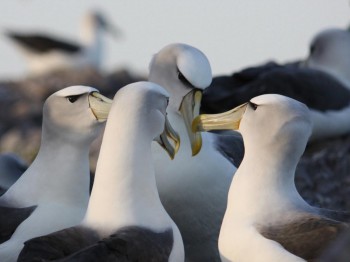A group of 32 people involved in seabird scientific and policy work met for a day of short seminars and informal discussions on 4 June 2013 in Hobart, Australia at the CSIRO (Commonwealth Scientific and Industrial Research Organisation) Division of Marine and Atmospheric Research headquarters.
The proposal for the day came from an informal gathering held in March this year of a small group (about half a dozen people), involved with the Albatross and Petrel Agreement who met before the Seventh Meeting of ACAP’s Advisory Committee (AC7) to exchange ideas and information relevant to the meeting’s agenda. The small group noted that there was a large number of people based in Hobart who are involved in work relevant to the conservation of seabirds and there is benefit from improved exchange of information amongst the Hobart seabird community.
The gathering at CSIRO brought together an extensive range of skills and interests, including researchers, managers and students involved with the University of Tasmania, the Institute of Marine and Antarctic Studies, the Australian Antarctic Division, CSIRO, the Tasmanian Government and BirdLife International, along with staff from the Hobart-based ACAP Secretariat and several others involved in the work of ACAP. The diversity of expertise and knowledge was reflected in the scope of topics presented which included:
a) status and trends of Antarctic seabirds;
b) investigating seabird diet using faecal DNA techniques;
c) estimates of seabird bycatch rates at the ocean/hemisphere scale;
d) bycatch history in the Indian Ocean and possible impacts on seabirds;
e) environmental and anthropogenic influences on populations status and trends of four species of Macquarie Island albatrosses;
f) impacts of climate change on Indian Ocean albatrosses;
g) prioritisation tools for evaluating climate change adaptation options for seabirds and marine mammals;
h) managing for climate change: modelling the effect of changing environment on Shy Albatross Thalassarche cauta;
i) an approach to improving ACAP’s best practice line weighting advice for pelagic longline fisheries;
j) CCAMLR: a success story;
k) global risk assessment of marine debris impacts on seabirds;
l) applying biogeochemical and genetic markers to understand movement in complex systems; and
m) seabird bycatch in gillnet fisheries.

Shy Albatrosses on Australia's Albatross Island
Photograph by Rachael Alderman
Noting the enthusiastic response of attendees (with several regretful apologies) and the extraordinary diversity of work being conducted, the group agreed to meet again in early December with further updates on studies being conducted by local seabird researchers.
Ian Hay, 19 June 2013

 English
English  Français
Français  Español
Español